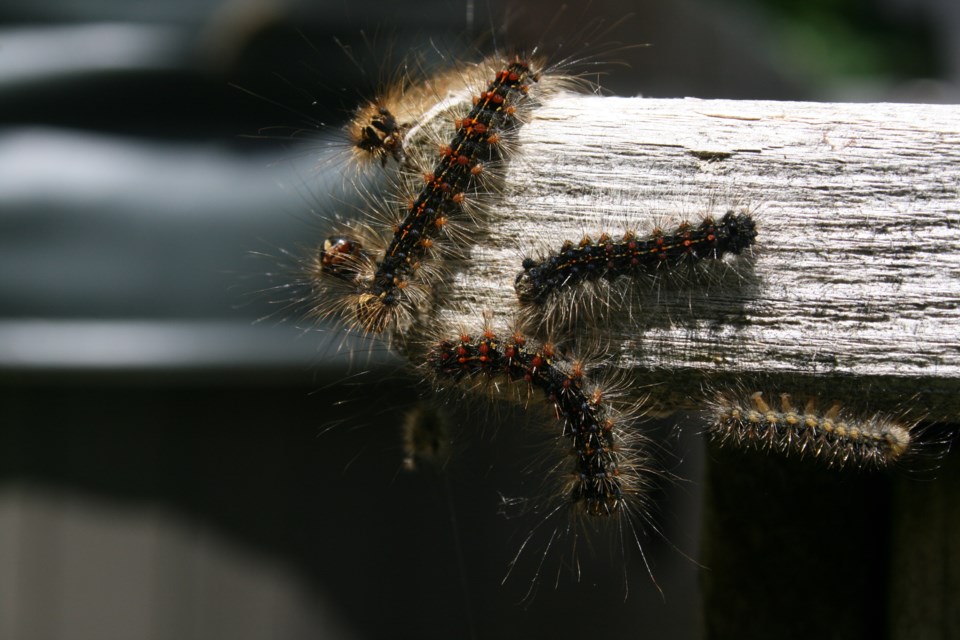Who do you call if a furry grub is infesting the trees in your yard? The Severn Sound Environmental Association (SSEA).
Michelle Hudolin, wetlands and habitat biologist with the SSEA, says people have been calling them about infestations they're noticing on the trees in their property woodlots.
"We started getting calls about it in 2019 and about noticeable damage this year," she said, adding most recent calls have been received from various parts of Tiny Township. "It likely started on the increase in 2018, but became much more noticeable in 2019 and more so in 2020."
The Ministry of Natural Resources and Forestry monitors the impacts of the infestation.
"Once we see the mapping the ministry has done, we will have a better idea of what the population was," said Hudolin.
However, she said it's safe to say every seven to 10 years there tends to be an increase in the gypsy moth population so it becomes a more serious pest.
"Most recent outbreaks have only lasted two to three years so we're hoping this one will follow the same pattern," added Hudolin.
The moth, which is considered an invasive species, was brought to North America in the 1860s from Europe. It spread to Ontario about 100 years later.
"The population surges every seven to 10 years. It cannot be completely eradicated and is expected to have periodic population fluctuations," Hudolin said in an SSEA YouTube video.
An adult male moth is winged, brown, and has feathery antennae and non-flying females are white and lack mouths, she said.
"The species has two weeks for mating and egg-laying," said Hudolin. "And the eggs can be found on trees, outdoor furniture, buildings, and other surfaces from late summer through spring."
The moth feeds on the leaves of more than 300 host plant species, mainly hardwood trees, but also some evergreens, such as pine, she said.
"It also has to do with population levels," Hudolin noted. "When it's higher, they have to branch out and eat different vegetation."
The general observation is that trees can survive significant defoliation over a couple of years, she said.
"The trees in our areas have been able to survive the gypsy moth outbreaks in the past," said Hudolin.
However, she added, trees may have trouble surviving the defoliation if it's a hot summer with a drought or if the tree is unhealthy to begin with.
There are a number of different environmentally friendly ways of helping disrupt the moth population, she said, adding the effectiveness of the method depends on the life stage of the moth.
"At this time of the year, there are no caterpillars left," said Hudolin. "The females have left the egg masses, on the trees, eaves of the houses, they could be on things laying around the yard, a shed, and even sometimes on the ground.
"One of the things people can do between now and early spring is to destroy those egg masses. Easiest thing to do is to scrape them off the surface and into soapy water and leave them there for a few days to ensure the eggs are smothered and dead," Hudolin explained.
This can be done during winter, too, when the egg masses become more visible once the leaves come off, she said.
"If we get a really cold winter, that can kill the egg masses that are above the snow line," said Hudolin.
Once the eggs have hatched into caterpillars in spring, they will come down the trees to avoid the heat and then go back up the tree, she said.
"If you put a burlap skirt on the tree, they will hide under there," said Hudolin. "If you check, you can collect them and put them in soapy water. Make sure you wear gloves because their hairs can be irritating for the skin."
The same procedure can be done during the pupal stage, she added.
Other than that, Hudolin said, there are some natural controls as well, such as the black-billed cuckoo, which is a specialist hunter of a lot of a variety of hairy caterpillars.
There are also insecticides available that can be either injected into a tree or sprayed on the leaves.
"It's up to landowners to decide whether or not to have incesticides applied," said Hudolin, adding this method has to be applied shortly after the eggs hatch. "The injection only protects the one tree that's injected with it. It doesn't protect the entire woodlot and it only protects for a season."
In addition, pheromone traps are used more to surveil the population, she said.
Sometimes, said Hudolin, the trees themslves will naturally make changes to defend themselves against some of these predators.
"After it starts to be affected by the caterpillar, (the trees) can start to produce leaves that are tougher and less nutrient," she said. "Sometimes once the caterpillars are done feeding, the deciduous trees will put out another flush of leaves."
Residents are welcome to contact the SSEA at [email protected] for more information or to report an infestation.


